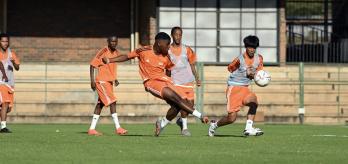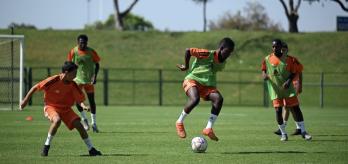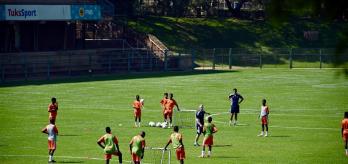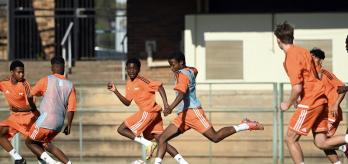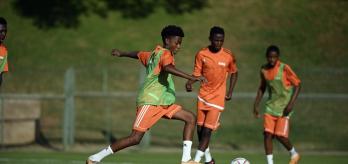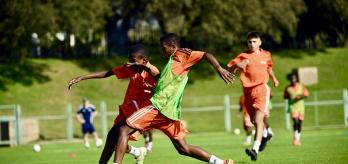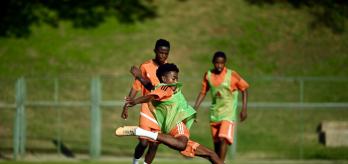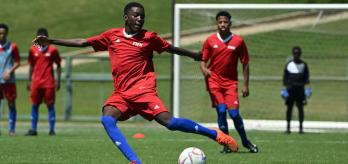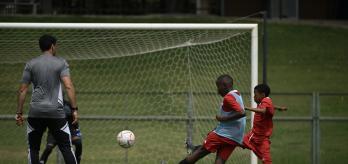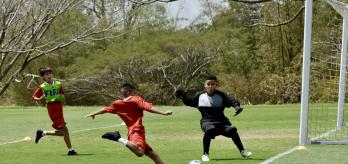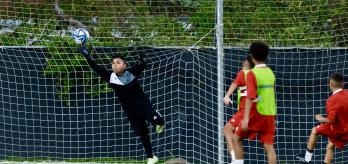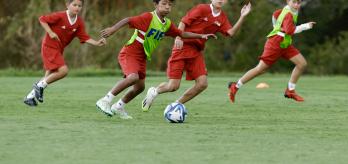Methodology
The intention: What is practised?
The objective of the exercise is to improve a team’s ability to create and finish within a narrow focus. The drill specifically focuses on team-level aspects, such as progressing play through the thirds by using connecting links and operating in an organised structure. The team should set up in a 2-2-2 formation and are tasked with identifying moments in which a player can drop into the build-up third to become a link to create overloads that will help to open space for team-mates to receive possession in more advanced areas. Quick combinations and support actions that help team-mates before they come under pressure can help the team to progress the ball much more efficiently. From a defensive perspective, the team’s objective is to deny and protect by pressing aggressively and maintaining their compact defensive structure.
The scale: For whom is this relevant?
This small-sided game revolves around the team level, focusing on playing in tight spaces and progressing play through the zones. The exercise is relevant to players who operate centrally during the build-up phase and seek to create goalscoring opportunities, with the focus on progressing the ball through three zones. The two players positioned in the build-up zone represent centre-backs operating on the same line. They initiate the attack, with a number 6 able to drop into the build-up third from the middle third to receive the ball, creating a 3v2 overload. The number 8 waits inside the middle zone to provide a support option for a possible progressive pass into the final third, where two fixed attackers wait on the opposition’s defensive line, ready to make runs in behind or provide another link. The two neutral players operate as number 10s or additional attackers and are able to roam inside the opposition’s shape to find space with a view to connecting play or making deep runs behind the defensive line.
The practice type: How is the practice designed?
The exercise involves a small-sided game and includes variable repetition that provides an abundance of opportunities for a team to practise offering to receive, the movement to receive and passing when creating goalscoring chances. The reduced size of the pitch is designed to limit players’ space and time on the ball, thereby encouraging quick decisions and actions. Players are restricted to their respective thirds to ensure that attacking and defensive structures are maintained, and connections to progress play should be match-realistic. Overloads can be created in each third, with a player allowed to drop into the build-up third and the neutral players able to float between the middle and final zones, which should help to increase the number of ball progressions. The offside rule applies to ensure that attackers remain alert and time their runs properly.
Session plan
Organisation
-
Mark out a 25x15m field and position a full-size goal at each end of the exercise area.
-
Divide the exercise area into thirds.
-
Set up a 7v7 including goalkeepers (plus 2 neutral players) inside the exercise area.
-
Organise the players so that each team have 2 players in each third, while the 2 neutral players can roam freely.
Explanation
-
The exercise starts with one of the 2 goalkeepers in possession.
-
The goalkeeper plays the ball to a player in the build-up third, and they try to build up play through the thirds to score in the opposite goal.
-
The 2 neutral players support the in-possession team, but they cannot be positioned in the same third at the same time.
-
The out-of-possession team try to win the ball back and score.
-
With the exception of the 2 neutral players, players must stay in their designated thirds.
-
When their team are in possession in the build-up third, 1 player is allowed to drop from the middle third into the build-up third to create an overload.
-
The offside rule applies, with the offside lines marked out by the end of the build-up zones at each end of the exercise area.
-
Rotate the players so that they have the opportunity to perform different roles.
Key coaching points
Roles of coaches
-
First coach: explains the rules and objectives of the exercise whilst intervening from time to time.
-
Second coach: encourages the players from their position on one side of the exercise area.
- Third coach: encourages the players from their position on the opposite side of the exercise area to the second coach.






























